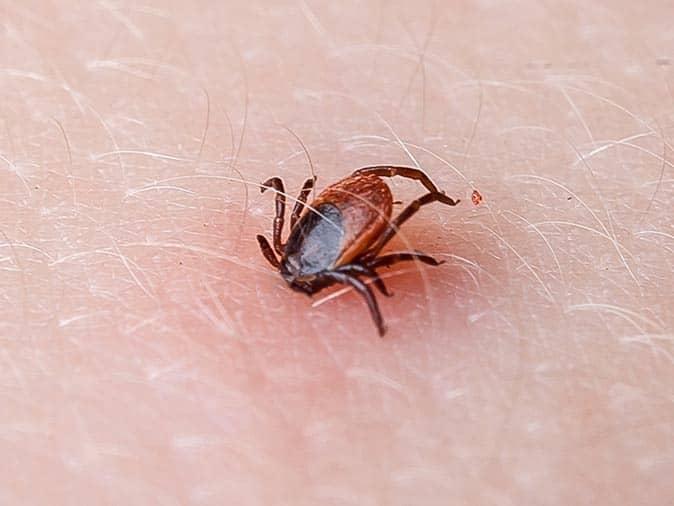If you’re thinking it’s only a matter of days before ticks will start to disappear, you’re not alone. In fact, many residents in Plainfield, Chatham, and Montclair as well as throughout New Jersey assume that ticks are not a significant problem or health threat in the fall. Unfortunately, that is not the case. Some ticks in New Jersey are not just a spring and summer pest problem.

What types of ticks in New Jersey are active in the fall?
The most common types of ticks in the Garden State are the American dog tick, brown dog tick, Lone Star tick, and the blacklegged tick AKA deer tick. While dog ticks and the Lone Star tick will become inactive as the weather grows colder, the same cannot be said of deer ticks. In fact, these biting pests are ramping up and will continue to be a problem while the ground temperatures remain above 45°F and air temperature remains above freezing. What’s more, in the fall and winter months nymphs will develop into adult deer ticks and begin a feeding cycle. Tick eggs will also be hatching during this time and seek out small animal hosts to feed on.
Do ticks die after the first frost?
On average, the first frost in New Jersey occurs early October. While the frost may kill mosquitoes and take out what’s left in your garden, it will not kill deer ticks. Like George Washington’s escape from New York in 1776, ticks will retreat when the first freeze occurs but they certainly will not give up the battle.
Where do ticks hide during the fall?
Ticks will take refuge in leaf litter when the temperatures are too cold. There they’ll wait until its warm enough to come back out. That’s why it is so important to keep wooded and brushy areas free of leaves, mulch, and other organic debris.
Can I get Lyme disease in the fall?
Any time deer ticks are active, the threat of Lyme disease is present. The fall months are no exception. According to the experts at the CDC, deer ticks must be attached for 36 to 48 hours or more before the Lyme disease bacterium can be transmitted. With that information in mind, we cannot emphasize enough how important it is to check your whole body – arms, legs, groin, armpits, scalp, etc.- for these disease spreading pests after spending any amount of time outside.
What are the odds of getting Lyme disease?
According to Michigan State University, more than 95% of Lyme disease cases in the U.S. are caused by deer ticks in Northeast, Mid-Atlantic, and North Central states. What’s more, in these areas, 20 - 30% of blacklegged tick nymphs and 50 - 60% of adult females are infected.
What can I do to prevent contracting Lyme disease and other tick-borne diseases?
Removing ticks on your body as soon as you discover them and ideally less than 36 hours from when they attached will help you reduce your risk of acquiring illness from ticks. Other tick bite prevention tips include:
- Wearing light-colored clothing to spot ticks easier.
- Use permethrin repellents to deter ticks.
- Inspect yourself, family members, and pets after spending any amount of time outdoors.
What do I do if I have a tick on me?
Here’s the CDC recommendations for removing a tick:
- Use fine-tipped tweezers to grasp the tick as close to the skin’s surface as possible and pull upward with steady, even pressure. Do not twist or jerk the tick as this could result in mouth-parts breaking off and remaining in the skin. If that happens, simply use tweezers to remove if possible or leave it alone to let the skin heal.
- Clean the bite area with rubbing alcohol or soap and water. Also wash your hands thoroughly.
- Dispose of the tick either by flushing it down the toilet or seal it up in a bag if you’d like to have it tested. Never crush the tick with your fingers.
- Once the tick has been removed, keep a watchful eye on the bite site and reach out to your doctor if you are concerned or if you notice a bull’s eye rash or other signs of Lyme disease.
Seasonal Tick Control From Arrow Pest Control
At Arrow Pest Control, we protect people and pets from ticks and the illnesses they spread with our seasonal tick control services. Designed to eliminate ticks (and mosquitoes!), our Bite Back! Program consists of monthly treatments starting in April and ending in October.
In April and October, one of our experienced pest control technicians will apply a granular tick treatment to your lawn to kill adult ticks as well as any other life stages lurking about. Months May through September, we’ll stop by to spray your property for ticks and mosquitoes. Our concentration will be on areas where these pests breed, rest, and wait for hosts.
While no pest control company can completely eliminate mosquito and tick populations, Arrow’s tick and mosquito treatments significantly reduce their numbers and allow you to enjoy your outdoor living space. Contact us today to learn more or to sign up for service!














